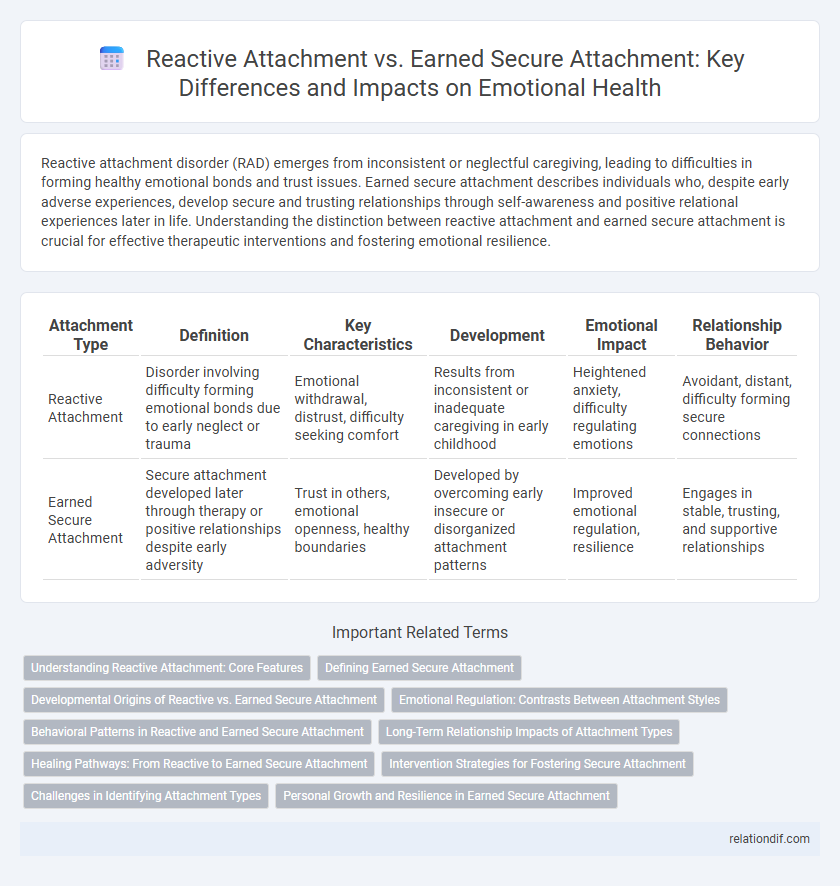Reactive attachment disorder (RAD) emerges from inconsistent or neglectful caregiving, leading to difficulties in forming healthy emotional bonds and trust issues. Earned secure attachment describes individuals who, despite early adverse experiences, develop secure and trusting relationships through self-awareness and positive relational experiences later in life. Understanding the distinction between reactive attachment and earned secure attachment is crucial for effective therapeutic interventions and fostering emotional resilience.
Table of Comparison
| Attachment Type | Definition | Key Characteristics | Development | Emotional Impact | Relationship Behavior |
|---|---|---|---|---|---|
| Reactive Attachment | Disorder involving difficulty forming emotional bonds due to early neglect or trauma | Emotional withdrawal, distrust, difficulty seeking comfort | Results from inconsistent or inadequate caregiving in early childhood | Heightened anxiety, difficulty regulating emotions | Avoidant, distant, difficulty forming secure connections |
| Earned Secure Attachment | Secure attachment developed later through therapy or positive relationships despite early adversity | Trust in others, emotional openness, healthy boundaries | Developed by overcoming early insecure or disorganized attachment patterns | Improved emotional regulation, resilience | Engages in stable, trusting, and supportive relationships |
Understanding Reactive Attachment: Core Features
Reactive attachment disorder (RAD) is characterized by consistent emotional withdrawal from caregivers and difficulty forming healthy attachments due to early neglect or trauma. Core features include inhibited social responsiveness, minimal positive affect, and failure to seek comfort when distressed, distinguishing it from earned secure attachment, which develops through consistent, reliable caregiving despite early adversity. Understanding these symptoms aids in diagnosing RAD and differentiating it from attachment styles shaped by therapeutic progress or stable relational environments.
Defining Earned Secure Attachment
Earned secure attachment refers to the development of a healthy, secure attachment style in adulthood despite experiencing early insecure or disorganized attachments in childhood. Individuals with earned secure attachment have often undergone significant personal growth or therapeutic work, enabling them to establish trust, emotional regulation, and stable relationships. This attachment style contrasts with reactive attachment disorder, which involves persistent difficulties in forming secure bonds due to early neglect or trauma.
Developmental Origins of Reactive vs. Earned Secure Attachment
Reactive attachment disorder (RAD) originates from early childhood trauma, neglect, or inconsistent caregiving, impairing a child's ability to form healthy emotional bonds. Earned secure attachment develops later in life through therapeutic intervention, positive relationships, or self-reflection, allowing individuals to reconstruct a secure attachment style despite adverse early experiences. Neurobiological research highlights differences in limbic system regulation and stress responses between individuals with reactive attachment and those with earned secure attachment.
Emotional Regulation: Contrasts Between Attachment Styles
Reactive attachment is characterized by difficulties in emotional regulation, often leading to heightened anxiety, mistrust, and difficulty forming stable relationships due to early inconsistent caregiving. Earned secure attachment reflects improved emotional regulation through self-awareness and reflective capacities developed over time despite adverse childhood experiences. These differences in attachment styles significantly impact emotional resilience and interpersonal functioning across the lifespan.
Behavioral Patterns in Reactive and Earned Secure Attachment
Reactive attachment disorder displays behavioral patterns marked by emotional withdrawal, difficulty forming trusting relationships, and impaired social responsiveness, often resulting from early neglect or inconsistent caregiving. Earned secure attachment, however, is characterized by reflective self-awareness, the ability to establish healthy, trusting bonds, and resilient emotional regulation developed through corrective relational experiences later in life. These contrasting behaviors highlight the influence of early attachment disruptions versus later emotional healing on interpersonal functioning.
Long-Term Relationship Impacts of Attachment Types
Reactive attachment often leads to difficulties in forming trust and emotional intimacy in long-term relationships, resulting in instability and increased conflict. Earned secure attachment typically promotes healthier communication patterns and greater emotional resilience, fostering stronger, more stable partnerships over time. Understanding these attachment dynamics is crucial for addressing relational challenges and enhancing intimacy in enduring relationships.
Healing Pathways: From Reactive to Earned Secure Attachment
Healing pathways from reactive attachment to earned secure attachment involve developing consistent emotional regulation and fostering trust through therapeutic relationships. Individuals cultivate a coherent sense of self by addressing early attachment wounds, promoting resilience and adaptive interpersonal skills. Transformative therapy techniques such as attachment-based therapy and mindfulness strengthen secure relational patterns over time.
Intervention Strategies for Fostering Secure Attachment
Intervention strategies for fostering secure attachment target modifying relational patterns by promoting consistent, sensitive caregiving and building emotional availability. Therapeutic approaches, such as Child-Parent Psychotherapy (CPP) and Attachment-Based Family Therapy (ABFT), emphasize strengthening caregiver responsiveness and repairing attachment disruptions. Structured support programs often include caregiver training on recognizing infant cues, regulating affect, and providing nurturing experiences to shift reactive attachment toward earned secure attachment outcomes.
Challenges in Identifying Attachment Types
Distinguishing between reactive attachment and earned secure attachment poses significant challenges due to overlapping behavioral symptoms and complex emotional histories. Reactive attachment often presents through inconsistent trust and emotional regulation issues rooted in early neglect, while earned secure attachment reflects a conscious restructuring of attachment patterns through later positive experiences. Accurate identification requires nuanced assessment tools that consider both developmental context and current relational dynamics.
Personal Growth and Resilience in Earned Secure Attachment
Earned secure attachment fosters profound personal growth by enabling individuals to reorganize negative early attachment experiences into positive relational patterns, promoting emotional regulation and self-awareness. This resilience stems from the ability to develop trust and healthy interpersonal connections despite past adversities, enhancing adaptive coping mechanisms. Through therapy and self-reflection, those with earned secure attachment build strong, supportive relationships that reinforce secure attachment frameworks throughout their lives.
Reactive attachment vs earned secure attachment Infographic

 relationdif.com
relationdif.com